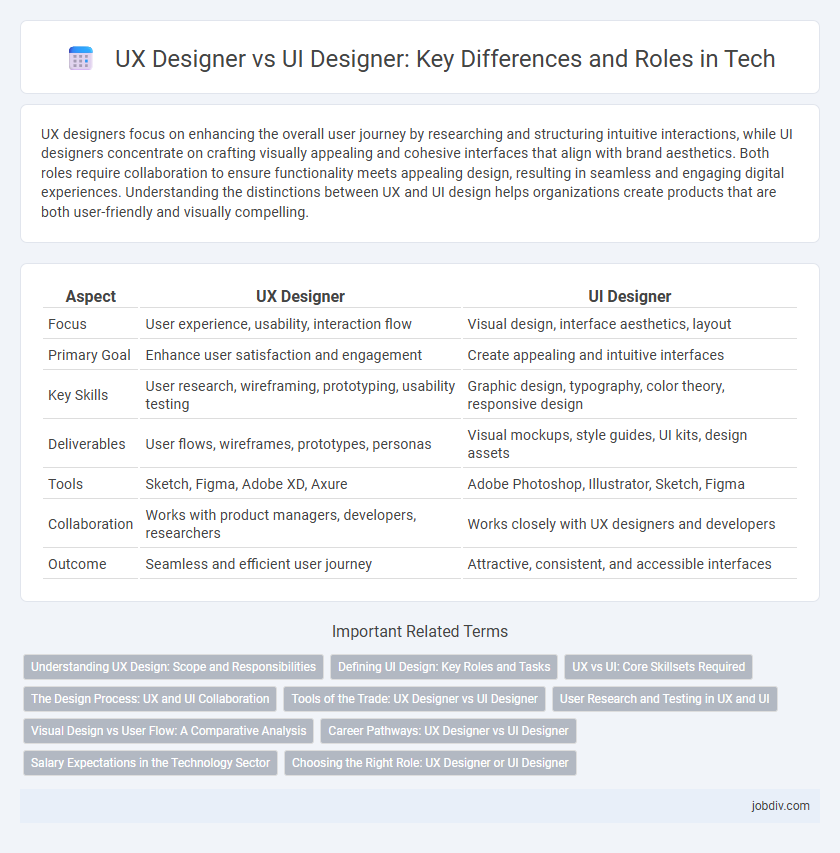UX designers focus on enhancing the overall user journey by researching and structuring intuitive interactions, while UI designers concentrate on crafting visually appealing and cohesive interfaces that align with brand aesthetics. Both roles require collaboration to ensure functionality meets appealing design, resulting in seamless and engaging digital experiences. Understanding the distinctions between UX and UI design helps organizations create products that are both user-friendly and visually compelling.
Table of Comparison
| Aspect | UX Designer | UI Designer |
|---|---|---|
| Focus | User experience, usability, interaction flow | Visual design, interface aesthetics, layout |
| Primary Goal | Enhance user satisfaction and engagement | Create appealing and intuitive interfaces |
| Key Skills | User research, wireframing, prototyping, usability testing | Graphic design, typography, color theory, responsive design |
| Deliverables | User flows, wireframes, prototypes, personas | Visual mockups, style guides, UI kits, design assets |
| Tools | Sketch, Figma, Adobe XD, Axure | Adobe Photoshop, Illustrator, Sketch, Figma |
| Collaboration | Works with product managers, developers, researchers | Works closely with UX designers and developers |
| Outcome | Seamless and efficient user journey | Attractive, consistent, and accessible interfaces |
Understanding UX Design: Scope and Responsibilities
UX Designers focus on optimizing the overall user journey by conducting user research, creating wireframes, and testing prototypes to ensure functionality and usability. Their responsibilities include understanding user needs, defining interaction flows, and improving product accessibility and satisfaction. The scope of UX design encompasses user-centered strategy, information architecture, and usability analysis to create seamless digital experiences.
Defining UI Design: Key Roles and Tasks
UI design centers on creating intuitive, visually appealing interfaces that facilitate user interaction with digital products. Key tasks include designing layout structures, selecting color schemes, typography, and ensuring consistency in visual elements across screens to enhance usability. UI designers collaborate closely with developers to implement responsive designs that adapt seamlessly across devices and platforms.
UX vs UI: Core Skillsets Required
UX designers excel in user research, wireframing, and usability testing to create intuitive and efficient experiences, emphasizing user behavior and journey mapping. UI designers specialize in visual design, typography, color theory, and interactive elements to ensure aesthetically pleasing and accessible interfaces. Both roles require proficiency in design tools such as Sketch, Figma, or Adobe XD but differ in focus: UX prioritizes functionality and user flow, while UI centers on look and feel.
The Design Process: UX and UI Collaboration
UX Designers focus on user research, information architecture, and wireframing to create intuitive experiences, while UI Designers concentrate on visual elements such as typography, color schemes, and interactive components to enhance aesthetics and usability. Their collaboration during the design process ensures a seamless integration of functionality and visual appeal, leading to products that meet user needs and provide engaging interfaces. Effective communication and iterative feedback loops between UX and UI teams drive continuous improvements and alignment with business goals.
Tools of the Trade: UX Designer vs UI Designer
UX Designers primarily utilize tools like Axure, Sketch, and Balsamiq for wireframing, prototyping, and user research analysis, emphasizing functionality and user journey mapping. UI Designers depend heavily on Adobe XD, Figma, and Photoshop to create visually compelling interfaces, focusing on color schemes, typography, and interactive elements. Both roles collaborate using platforms such as InVision and Zeplin to ensure seamless transition from conceptual design to development.
User Research and Testing in UX and UI
User research and testing in UX design centers on understanding user behaviors, needs, and motivations through methods like interviews, surveys, and usability testing to inform the overall user experience strategy. UI designers use testing to evaluate interface elements such as buttons, icons, and layout aesthetics, ensuring visual appeal and functional interaction align with user expectations. Both roles rely on iterative feedback loops but UX emphasizes holistic experience optimization while UI targets the efficiency and pleasure of visual design components.
Visual Design vs User Flow: A Comparative Analysis
UX Designers prioritize user flow by mapping intuitive pathways that enhance usability and ensure seamless interactions, while UI Designers focus on visual design, crafting aesthetically pleasing interfaces with consistent typography, color schemes, and iconography. The distinction lies in UX's strategic approach to optimizing user journeys across digital platforms versus UI's emphasis on the interface's look and feel to engage and guide users effectively. Both roles collaborate closely to balance functionality with visual appeal, crucial for delivering compelling digital experiences.
Career Pathways: UX Designer vs UI Designer
UX Designers typically begin their career by mastering user research, wireframing, and prototyping, evolving into roles such as UX Architect or Product Designer. UI Designers focus on visual design skills, tools like Sketch or Figma, and interactive design, progressing toward positions like Visual Designer or Design Lead. Both career pathways require continual learning in user-centered methodologies and collaboration with development teams to create cohesive digital experiences.
Salary Expectations in the Technology Sector
UX Designers in the technology sector typically earn an average salary of $85,000 to $110,000 annually, reflecting their focus on user research and experience optimization. UI Designers' salaries range from $75,000 to $100,000 per year, emphasizing skills in visual design and interface aesthetics. Salary variations depend on factors such as geographic location, company size, and level of expertise within the fields of UX and UI design.
Choosing the Right Role: UX Designer or UI Designer
Choosing the right role between UX Designer and UI Designer depends on your passion for user research versus visual design. UX Designers specialize in user experience strategies, wireframing, and usability testing to create intuitive, seamless interactions. UI Designers concentrate on crafting engaging visual elements, including typography, color schemes, and interactive components that enhance the product's aesthetic appeal.
UX Designer vs UI Designer Infographic

 jobdiv.com
jobdiv.com